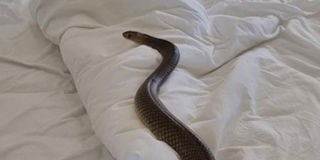Prime
Places habouring snakes in the bedroom

Your bedroom is more likely to provide the retreat they crave. PHOTOs/NET.
What you need to know:
Snakes seek out dark and sheltered areas to hide. Clear clutter from the yard and keep storage areas neat. Remove bricks and logs, as they can provide ideal hiding spots for snakes.
Most people are scared of snakes but finding one in your bedroom is likely to cause panic even in the bravest people. The bedroom, experts reveal is one of the favourite spots for snakes to hide.
Why the bedroom?
Snakes are cold blooded, meaning they rely on external sources of heat to regulate their body temperature. Therefore, while they might be hiding from direct heat, they will still seek warmer areas such as your bed for warmth.
Additionally, snakes are generally introverted creatures that prefer to be on their own. Your bedroom, unlike any other space in the house is more likely to provide the retreat they crave.
The quiet and darkness in the bedroom enables them to sleep during the day and get active during the night. Some snake species are diurnal, meaning they are active during the day and may find your bedroom the perfect shelter to sleep at night.
Where?
In the bed
A colleague recently shared a horrifying story of finding a snake hiding in their bed. “As I was preparing to get into the bed, I noticed a movement in the bed. Since I do not have pets, my mind became alert. I uncovered the bed gently, and there lying between the covers was a six foot snake,” he recollects.
Under the bed
Snakes often end up indoors because they are exploring a food trail. If you have rodent or cockroach infestation in the space under the beds chances are they will end up there. If they find the space beneath them dark and cluttered they will stick around.
The toilet
With the current heat wave, there is a danger that snakes in search of a cool space will end up in your toilet bowl.
Keep them out of the bedroom
As with any infestation, prevention is the best policy. It is therefore important to block any spaces snakes could use to find their way into a home. This includes holes, cracks and gaps in the home. Inspect the exterior of the house and seal any gaps in walls, windows, doors, and vents. Pay special attention to areas where pipes and wires enter the house.
Also eliminating hiding spaces and clutter will prevent snakes from finding optimal places to hide in. Similarly, endeavour to control the food supply around the property by getting rid of rodent infestations. Regularly remove debris, brush, and woodpiles from near the house, as these can provide hiding spots and attract prey. Trim vegetation and keep the grass short to minimise snake-friendly environments.
When you discover a snake
Discovering a snake in your home, especially in the bedroom is enough to cause panic. However, for your safety try to remain calm and avoid any sudden movements that may startle the snake. It is important to remember that most snake encounters result from the snake being accidentally disturbed or seeking shelter. Therefore, it is recommended to give the snake an escape route and slowly back away from it.
If the snake is in a confined space and cannot leave, and you are forced to remove it, it is important to do so with caution. Use a long object, such as a broom to gently guide the snake towards an open door or window. Avoid touching the snake with your bare hands as this may provoke a defensive reaction. It is also advisable to wear protective gloves or use container to safely capture the snake if necessary.
Repellents
Snake repellent plants can be hugely important if you live in an area where these unwelcome reptiles thrive. These plants include holly, marigolds, lemongrass, mother-in-law’s tongue (snake plant), wormwood or mugwort, pink agapanthus and garlic.



